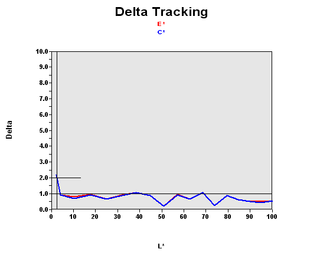Shuttle Enters Monitor World with XP17 LCD
Rich Color

The monitor's color rendering is excellent: 94% of the colors are displayed with a Delta E of less than 2. There is a slight peak in the blacks, which is normal for a TFT monitor. Having said that, the color rendering is exceptional and much better than our Prophetview 920 Pro!
Light and shadow
After calibration, we obtain the values following for contrast and brightness.
| White Spot | Black Spot | Contrast |
|---|---|---|
| 125.8 | 0.28 | 449.28 |
Contrast and brightness are very satisfactory.
In addition, using our second sensor, we measured the stability of the contrast as a function of brightness. It's important that contrast remain constant through brightness adjustments. You'll be tempted to play with the brightness settings to suit your ambient lighting, and it would be a shame for the contrast to break down when the brightness increases.
Obviously the ideal would be for the contrast and brightness adjustments to be truly independent. But such is not always the case.
We end up with the following curve for the XP17:

The brightness setting is on the X-axis; contrast is on the Y-axis. Contrast is expressed here as a percentage of the maximum value for contrast as measured according to the ANSI standard. Here, maximum contrast is obtained with a brightness of 35%.
Stay on the Cutting Edge
Join the experts who read Tom's Hardware for the inside track on enthusiast PC tech news — and have for over 25 years. We'll send breaking news and in-depth reviews of CPUs, GPUs, AI, maker hardware and more straight to your inbox.
As can be seen, contrast is stable over nearly 50% of the use range (from 50 to 100%). In any event it's within that range, in the neighborhood of 68%, that the best calibration can be achieved. That's not bad, but Eizo, for example, does significantly better in this area. But for ordinary, non-professional use, you'll always be able to find the best adjustment.
Most Popular

